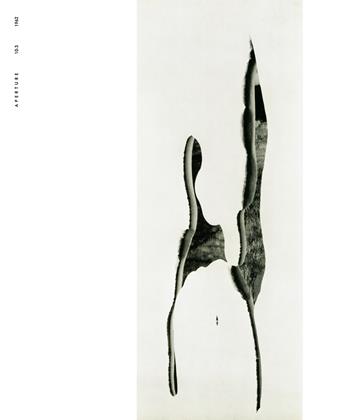THE BITTER YEARS
Being comments aroused in a reviewer by the exhibition of Farm Security Administration photographs in the Museum of Modern Art, selected by the Director Emeritus of the Photography Department, Captain Edward Steichen, displayed in New York City during the Fall of 1962.
Something happened in photography about twenty five years ago when a dozen photographers, all rather young*, under the direction of Roy Stryker, collectively photographed the miserable plight of thousands of sharecroppers, "plowed out, and stormed out” and their Westward migration. This something that happened twenty five years ago was something true, and true beyond the visible record of drouth and deprivation. There was an unusual, very unusual meshing of the medium of photography with some human needs. An entanglement, or maybe an integration, occurred between the deep needs for food, shelter and work of those persons who were photographed, the profound personal needs of the photographers themselves to ask for help with pictures, for these unfortunates the response of those who because they witnessed the pictures did a little bit for the desperate one third of a nation, and those who saw in these images themselves; and so, remembered for a moment that, except for the Grace of God, such misery might be their lot — and were rightfully afraid for a fraction of a second.
Rare are the "moments” of truth in the history of photography and the vast collection of images in the former Farm Security Administration files is the stilleffective residue of one such period. Previously another such "moment” occurred during the Civil War when several photographers under Mathew Brady documented that bloody conflict with huge view cameras. Brady was, if the parallel holds, a prototype of Stryker, that is, coordinator and the source of inspiration. (Brady was also the promoter and financial backer as well.) During World War II the photographers under Edward Steichen made a deliberate effort to bring about another such "moment” of truth.
High hopes were raised by the Museum of Modern Art’s announcements of The Bitter Years. Anticipations, however, of the major impact of great quantities of FSA images were not fulfilled. The thousands of images were represented by a handful of 200 or so,
and no matter how excruciatingly desperate the task of selection was, 200 prints is not 800. Consequently powerful as the images are, and medium-sized monumental as the exhibition is, some warping took place. In this show the humor, the wry humor of many of the FSA images were omitted. By intention or otherwise the exhibition shrunk a shrieking indictment, refashioned a period of brutal truth so that tender-hearted New Yorkers might not be offended. The totality of the FSA images are both offensive and, in the right context, an offensive.
The present reviewer is probably some kind of a sample of those who have taken to their hearts various of these powerful FSA images and lived with them most of their adult lives. To see these same images again, hanging, was a complex experience. There they were, rather like tombstones on a masoleum wall now, at first nostalgic. . . then once again the long-lived-withfavorites gripped. This reviewer wonders if young Americans can ever know what these images meant and still mean to us. While it is not important to them to even have the faintest idea of what these images mean to us; still, what do they mean to young Americans?
To acquaint the younger generation with the facts that such images exist, more such exhibitions need to be mounted and seen. Acquaintance is not enough, such exhibitions must reach, inform and above all provide the experience of the documents and the period and the truth. Magnificent as the exhibition was, F he Bitter Y ears did not seem, to this reviewer at least, to be presented in such a way that a young American viewer would get an unmistakable, stinking whiff of the misery and evil inherent in mankind.
The images selected had the stuff of misery visible and if any one would engage the images directly and intently he might have the direct experience. Poet Sandburg’s poems were a diversion, the mounting of the exhibition likewise. The direct quotations from the people photographed were honest and so could help direct a young gallery-goer on a stroll to the significance of the images. Whether any young resident of New York City ever discovered it for himself or not, actually when he was looking at those FSA images, each for its own sake, he was faced with his own animal instinct for survival and his own inhumanity to man.
MINOR WHITE
Subscribers can unlock every article Aperture has ever published Subscribe Now
Minor White
-

Sequence 17
Winter 1978 -

Book Reviews
Spring 1968 By Jonathan Green, Minor White -

Criticism
Fall 1953 By Minor White -
 Editorial
EditorialA New Basic Problem
Winter 1953 By Minor White -
 Book Reviews
Book ReviewsHelmut And Allison Gernsheim / The History Of Photography
Fall 1956 By Minor White -
 The Education Of Picture Minded Photographers
The Education Of Picture Minded PhotographersA Unique Experience In Teaching Photography
Winter 1956 By Minor White





